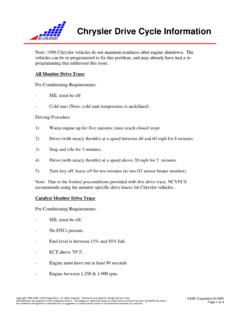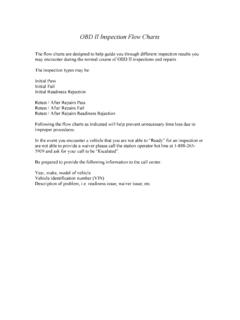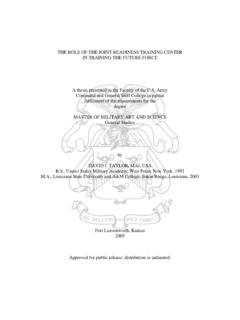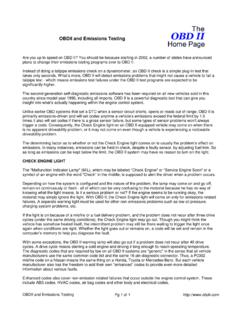Transcription of READINESS FAILURE FACT SHEET - City of New York
1 1 READINESS FAILUREFACT SHEETB eginning in January 2005, the New York City Taxi and Limousine Commission (TLC) willimplement mandatory on-board diagnostics (OBD II) inspections on all medallion taxicabs. OBDinspections will apply to most model year 1996 and newer light duty vehicles. For Hire vehicles,regulated by the TLC will also undergo an OBDII inspection. Instead of the existing tailpipeinspection at an approved NYS inspection facility 3 times a year, the OBD inspection will beperformed using NYVIP equipment beginning spring of 2005. While the actual testing equipmentvaries, the testing criteria and guidelines described below will apply to both types of IS A MONITOR?An essential component of every OBD II inspection is the READINESS check of each applicablemonitor. The READINESS evaluation is part of the final OBD II inspection result, and it couldpossibly be the only reason why a vehicle fails the TLC emissions complete an OBD inspection, the TLC and NYVIP test equipment makes an electronic requestfor information to the vehicle being inspected through a standardized connector.
2 The subjectvehicle responds back to the testing equipment with information including the status ( on or off )of the Malfunction Indicator Light (MIL) and the READINESS status of the emissions control listed below, these individual emissions control systems are commonly referred to as monitors. While there are eleven possible monitors, currently no vehicle has all 11 monitorspresent. Misfire (continuous) Fuel Trim (continuous) Comprehensive Components (continuous) Catalyst (CAT) Exhaust Gas Recirculation (EGR) Evaporative (EVAP) Oxygen (O2) Sensor Secondary Air Heated Catalyst Air Conditioning (AC) System O2 Sensor HeaterThe exact number of monitors in any vehicle depends on the motor vehicle manufacturer semissions control strategy. Note that the misfire, fuel trim, and comprehensive componentsmonitors are referred to as being continuous. These three monitors are found in every gasoline-powered OBD II vehicle, and are very different in design from the other eight monitors.
3 The threecontinuous monitors are constantly being tested and evaluated by the vehicle s computer, or powertrain control module (PCM), while the vehicle is running. Conversely, the other eight monitors arecommonly referred to as being non-continuous monitors, as certain conditions need to occurbefore a test or series of tests can be completed by the PCM. 2 The conditions necessary for the vehicle to run self-diagnostic testing are referred to as the enabling criteria. Some monitors require that the vehicle to follow a prescribed drive cycle routine as part of the enabling criteria. Some non-continuous monitors require two drive cycles dueto the need for a cool down and warm up periods in on the non-continuous monitor, variables such as speed, engine and ambienttemperatures, load, fuel level, as well as other conditions must be met for the monitor to perform itsself-test. For more information on drive cycles, see the discussion is very important to realize that the TLC and NY-VIP test equipment does not force the vehicleto perform testing on any monitor.
4 Rather, the equipment simply asks the vehicle forinformation. The TLC and NY-VIP units then make the READINESS determination based on theinformation IS MEANT BY MONITOR STATUS?As noted above, not all eleven monitors are present. When a particular emission control system isnot applicable to the vehicle being tested, the monitor is reported as Unsupported. The vehiclecannot self-test this monitor simply because it does not exist. Most gasoline-powered OBD IIvehicles have at least a few unsupported monitors. As expected, unsupported monitors have no rolein the overall READINESS evaluation or the overall OBD inspection monitors that are incorporated into vehicle manufacturer s emissions control design arereferred to as being Supported. Supported monitors need to be evaluated by the vehicle s most gasoline-powered light duty vehicles, the common range of the number of supported monitors ranges between six to eight.
5 When the vehicle s PCM completes testing of a particularmonitor, the READINESS system status will be reported as Ready or Complete. Once a monitoris set as Ready or Complete it will remain in this state unless diagnostic trouble codes (DTCs)are cleared by a scan tool or if the PCM s short term memory is erased by a power FAILURE ( ,disconnecting the battery).If the vehicle has not completed the testing of a supported monitor, the monitor status will bereported by the vehicle as Not Complete or Not Ready. New York State has adopted the federal Environmental Protection Agency (EPA) guidanceconcerning READINESS during OBD inspections. A vehicle will fail the TLC or NYVIP OBD IIinspection if enough monitors are reported as Not Ready or Not Complete. TLC regulatedvehicles from model year 1996 to model year 2000, inclusive, will fail if 3 or more monitors are setas Not Ready; while model year 2001 and newer vehicles will fail when 2 or more monitors arereported as Not Ready.
6 In summary, the READINESS status of OBD monitors are considered in making the OBD II pass orfail determination. For most gasoline-powered vehicles, this involves 3 to 5 monitors. 3 GENERAL READINESS GUIDANCE1. Operators should be advised against disconnecting their battery in an attempt to bypass theOBD inspection. This practice is counterproductive as it will lead to a READINESS -relatedfailure. The taxicab will have to be driven to re-set the monitors, and then return for a Operators are encouraged to have emissions-related repairs completed when they are firstidentified by the illuminated MIL. A delay in effective repairs may result in increased fuelcost due to reduced fuel economy and potentially more costly repairs in the Operators should realize that some vehicles are more difficult to make Ready than othersand multiple attempts at completing a recognized drive cycles may be II - REPAIR SUGGESTIONS1.
7 Consult technical service bulletins (TSBs) before attempting repairs. If it is a commonproblem that has already been documented, it will save you a lot of time and Use a professional grade scan tool to verify that the MIL is not commanded on. Confirmthat there are no diagnostic trouble codes (DTCs) which may prevent a monitor fromrunning to Use the OBD generic function on the scan tool, as these results may differ from themanufacturer specific The practice of clearing codes should be used sparingly as possible, as all monitors will bere-set as Not Ready when this occurs. Whenever possible, instead of clearing codes aftercompleting a repair, drive the vehicle sufficiently to allow the PCM to extinguish the MILby Verify that the most current version of manufacturer s firmware (PCM software) is installedon the vehicle s computer, as the vehicle may need an upgrade to operate Follow recommended diagnostic practices and procedures.
8 Aimlessly replacing parts in anattempt to remove a DTC is generally ineffective and potentially very costly for themotorist. For example, an oxygen related DTC could actually be the result of an exhaustleak upstream of the O2 sensor. In this case, replacing a properly functioning O2 sensor willnot resolve this Check the fuel level in the vehicle. Some monitors, in particular the EVAP monitor, mayrequire the fuel level to be between 35% and 85% of full to initiate diagnostic Continuing education and training related to OBD repairs is recommended. 4 RUNNING AN OBDII drive CYCLEThe purpose of completing an OBD II drive cycle is to force the vehicle to run its onboarddiagnostics. Some form of drive cycle needs to be performed after DTCs have been erased fromthe PCM s memory or after the battery has been disconnected. If a TLC vehicle failed the OBDinspection for READINESS , running through a prescribed drive cycle will set the READINESS monitorsto Complete so that the vehicle can be re-inspected and that future faults can be detected.
9 Thedrive cycles for Ford Crown Victorias, as well as other vehicle drive cycles, can be found under Vehicle OEM Database or within the vehicle s you would like more information on OBD or READINESS monitors, visit the following
















